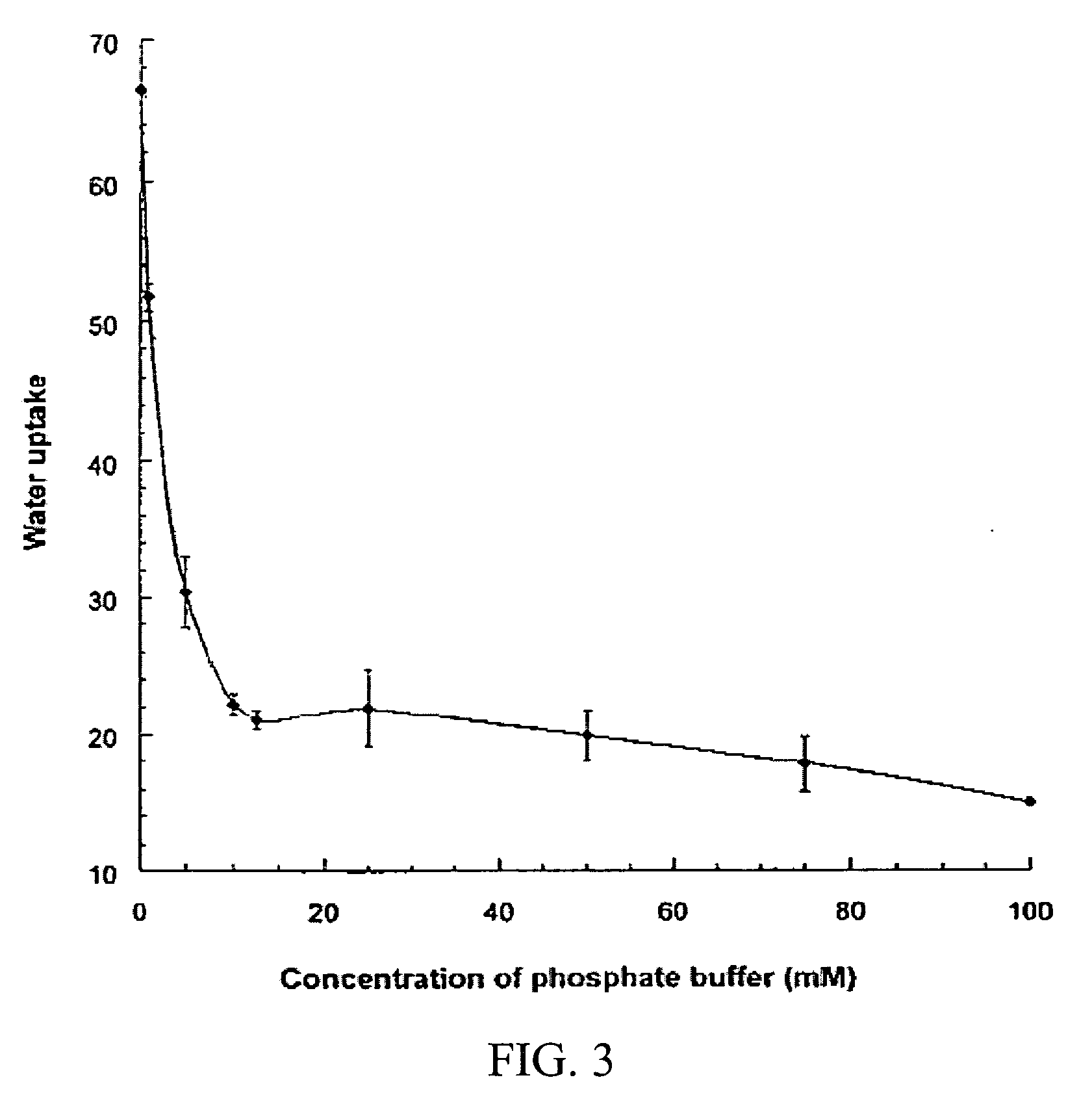Hydrogel-containing medical articles and methods of using and making the same
a technology of medical articles and hydrogels, applied in the field of medical articles, can solve the problems of scar formation, affecting the quality of life of affected patients, and imposing an enormous burden on society in terms of productivity and health care costs, and achieves the effects of preventing and/or treating, being easy to apply, and being inexpensive to mak
- Summary
- Abstract
- Description
- Claims
- Application Information
AI Technical Summary
Benefits of technology
Problems solved by technology
Method used
Image
Examples
example 1
Activation of PEG Using P-Nitrophenyl Chloroformate Catalyzed by Triethylamine (TEA)
[0188] PEG of various molecular masses (n varying from 45 to 800) were activated using p-nitrophenyl chloroformate to obtain PEG dinitrophenyl carbonates (Fortier et al. (1993) BIOTECH. APPL. BIOCHEM. 17: 115-130). Before use, all PEGs had been dehydrated by dissolving 1.0 mmole of PEG in acetonitrile and refluxing at 80° C. for 4 hours in a Soxhlet™ extractor containing 2.0 g of anhydrous sodium sulfate. The dehydrated solution containing 1.0 mmole of PEG was activated in the presence of at least 3.0 mmoles of p-nitrophenyl chloroformate in acetonitrile containing up to 5 mmoles of TEA. The reaction mixture was heated at 60° C. for 5 hours. The reaction mixture was cooled and filtered and the synthesized PEG-dinitrophenyl carbonate (PEG-NPC2) was precipitated by the addition of ethyl ether at 4° C. The percentage of activation was evaluated by following the release of p-nitrophenol (pNP) from the P...
example 2
Activation of PEG Using P-Nitrophenyl Chloroformate Catalyzed by Dimethylaminopyridine (DMAP)
[0189] PEG 8 kDa (363.36 g; 45 mmoles) was dissolved in anhydrous methylene chloride (CH2Cl2) (500 mL), and p-nitrophenyl chloroformate (19.63 g) was dissolved in anhydrous CH2Cl2 (50 mL). Both solutions were then added to a reaction vessel and stirred vigorously for about one minute. To this solution was then added a previously prepared DMAP solution (12.22 g of DMAP was dissolved in 50 mL of anhydrous CH2Cl2) while stirring was continued. The reaction mixture was then stirred for an additional 2 hours at room temperature.
[0190] The reaction mixture was concentrated and precipitated using diethyl ether (2.0 L) cooled to 4° C. The resulting suspension was then placed in a refrigerator (−20° C.) for a period of 30 minutes. The suspension was vacuum filtered and the precipitate washed several times with additional cold diethyl ether. The washed precipitate was then suspended in water, stirre...
example 3
Solvent-Free Activation of PEG Using P-Nitrophenyl Chloroformate
[0191] PEG 8 kDa (Fischer Scientific, 300.0 g, 37.5 mmol) was placed in a vacuum flask equipped with a thermometer and a stirrer. Upon heating to 65-70° C., the PEG powder began to melt. Once the PEG powder was completely melted, portions of p-nitrophenyl chloroformate (ABCR GmbH & Co. KG, Karlsruhe, Germany) comprising 33% of the equimolar amount of the terminal OH groups of PEG were added to the molten PEG at 15-minute intervals until a 200% excess of p-nitrophenyl chloroformate was added in total. The reaction mixture was stirred at 70-75° C. for two hours, then kept under vacuum overnight to remove residual HCl vapors. The crystallized PEG-NPC2 product was then ground into a powder and dissolved in water to prepare a crude PEG-NPC2 solution. To remove free pNP, weighted amounts of activated carbon (about 5 to 15 wt. % of activated PEG) was added to the PEG-NPC2 solution, followed by filtration. The filtered PEG-NPC...
PUM
| Property | Measurement | Unit |
|---|---|---|
| Size | aaaaa | aaaaa |
| Hydrophilicity | aaaaa | aaaaa |
| Biocompatibility | aaaaa | aaaaa |
Abstract
Description
Claims
Application Information
 Login to View More
Login to View More - R&D
- Intellectual Property
- Life Sciences
- Materials
- Tech Scout
- Unparalleled Data Quality
- Higher Quality Content
- 60% Fewer Hallucinations
Browse by: Latest US Patents, China's latest patents, Technical Efficacy Thesaurus, Application Domain, Technology Topic, Popular Technical Reports.
© 2025 PatSnap. All rights reserved.Legal|Privacy policy|Modern Slavery Act Transparency Statement|Sitemap|About US| Contact US: help@patsnap.com



